In just seven years’ time 1.8bn people will be living with absolute water scarcity. Tissue giant Kimberly-Clark (K-C) recently launched WaterLoupe, an analytical tool to advance the science of water sustainability… for its mills, the surrounding high risk river basins, for local communities, and the wider environmental source. Here, Vetrivel Dhagumudi, K-C global water programme leader, explains the strategy to TWM.
TWM/1: Why did K-C launch WaterLoupe? Can you explain the background behind it?
Dhagumudi: “K-C’s water strategies have traditionally been focused on conservation and reductions in water use and optimising wastewater treatment and quality at our mills. However, we have learned a local watershed approach is needed to address the broader challenges associated with of water security.
“We realised that lack of clean water availability could result in disruption of our operations, which would also be a problem for the communities and families relying on the watershed.
“K-C and Deltares developed the WaterLoupe dashboard as a tool to raise stakeholder awareness of water risks at the local level and to encourage collaboration in developing sustainable water management plans within watersheds of concern.
“Population growth is increasing the demand for water, at the same time a hotter, drier climate is threatening available supply. By 2025, according to U.N. projections, 1.8bn people will be living in regions or countries with absolute water scarcity and nearly two-thirds of the world’s population could be living under water-stressed conditions, up from one billion in 2005. The world’s poorest countries and the poorest communities within them are the most vulnerable to inadequate management of water resources.
“The introduction of WaterLoupe is the latest step in K-C’s global water risk management programme. It builds on long-standing efforts including:
• Investments in water recycling systems which have reduced the volume of freshwater used in its manufacturing operations by nearly 35m cubic metres between 2010 and 2016;
• Water security screening assessments to determine which K-C operations are at high risk for water stress, followed by watershed analyses and target setting for water-stressed locations;
• Engagement with key NGO partners and key stakeholders in the development of sustainable water management plans at the local level.”

TWM/2: What key issues are you and the tissue industry generally facing in terms of water sustainability?
Dhagumudi: “Water is one of the world’s most vital resources and a key input material to our tissue manufacturing operations. In 2015, we conducted a water risk screening assessment to determine which of our operations are at high risk for water stress, recognising that constraints on water supply could affect our future operations in these areas.
“On the production side, we are focused on mills in high water-stress locations to reduce water use, improve waste water treatment, and increase recycling of water within the production process.
“Decreasing water use in our mills is only part of the solution. We need to engage local stakeholders, including government, industrial and agricultural users, to develop total strategies for the sustainable management of local water resources to ensure we address both environmental and social needs within local communities.”
TWM/3: How does WaterLoupe work?
Dhagumudi: “WaterLoupe is an innovative web-based tool to share data and insights on current and future risks to local water resources. It tracks data on social, economic and climate factors impacting water availability within river basins and displays the information on a highly visual, user-friendly dashboard. The WaterLoupe dashboard visualises the water scarcity risks to all stakeholders at the local level and provides insights into water demand and supply, so that all parties can use freshwater more efficiently and sustainably now and in the future.
“Deltares developed the dashboard based on a study of the Aburrá and Cauca Valley catchment areas in Colombia, where K-C operates manufacturing facilities. K-C helped pilot the tool and provided input to its design based on our experience using dashboards for performance data within our manufacturing facilities. By employing WaterLoupe in Colombia, we aim to engage government authorities, farmers and industries in discussions regarding local water use and vulnerabilities now and in the future. We are now working on building a water stewardship goal, which will drive more impact on the basin level than reducing the mill’s water consumption.”
TWM/4: What is unique about it?
Dhagumudi: “The tools currently available in the market such as WRI – Aqueduct and the WWF water-risk filter use global data and are a starting point for identifying local water risks. WaterLoupe could be considered the next step in the process. The dashboard tracks hydrology, exposure and vulnerability at the local level using local data. The public and private sector can use this tool to engage local stakeholder groups to drive collective action for sustainable water stewardship in the river basin.”
TWM/5: What are the main opportunities and challenges in the next few years in terms of water sustainability, and how are you reacting to them?
Dhagumudi: “Water is an essential resource for K-C because our products require some form of water for their manufacturing. Through a focus on the mills which are located in high-stress water regions, we are establishing context-based, site-specific goals and proactive water management plans designed to deliver social, environmental and business benefits.”
TWM/6: How does WaterLoupe help the local community?
Dhagumudi: “The WaterLoupe tool allows users to assess local water risks for an entire watershed as well as specific sectors and sub-groups, such as industrial users, farmers and households, over a 30-year time horizon. Insights from WaterLoupe can help local stakeholders understand the challenges and participate in creating sustainable water stewardship goals and action plans.
“This ensures environmental objectives are integrated with those for economic stability and other social and cultural goals.”
TWM/7: How will you develop WaterLoupe?
Dhagumudi: “Ultimately, we hope to use this tool to develop water management plans for our mills and the surrounding communities. Over the next four years, K-C plans to extend this process to all of our mills located in high-risk watersheds. By 2022, we expect to have developed targeted goals and implemented appropriate plans to improve water security for these mills and the surrounding communities.
“The WaterLoupe tool will provide key insights to establish those goals and model the impact of potential solutions to meet them.
“At present, we are working with Deltares to further refine WaterLoupe and add capabilities that will enable users to explore different strategies to reduce local water risks, based on alternate environmental, social and economic scenarios. Over the coming months, K-C and Deltares will present the dashboard to their NGO partners and other manufacturers to obtain feedback on its functionality and content and identify further improvements.
“After the final improvements and additions have been implemented, we intend to make the WaterLoupe tool publicly available online.”


































